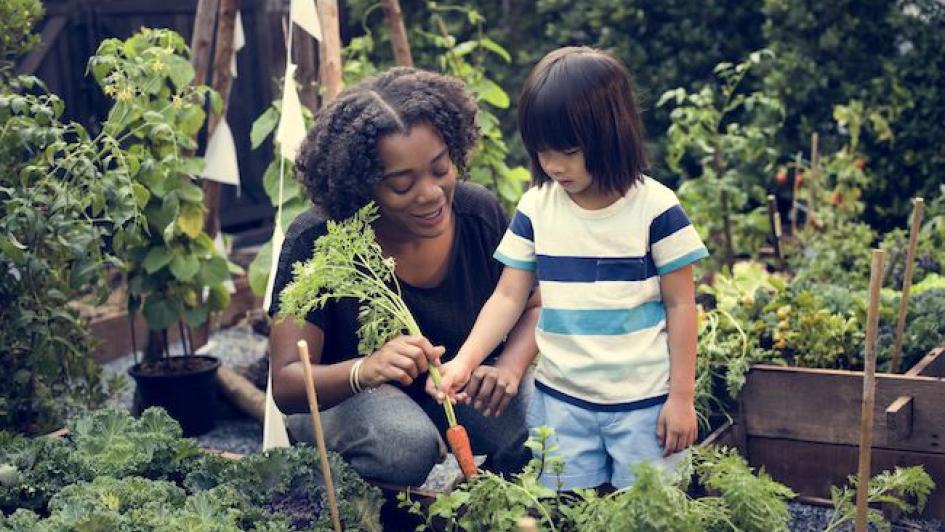4 Ways to Eat More Sustainably

Published
Have you ever wondered how you can eat more sustainably for the planet, the environment, and your health? If so, read on!
Sustainable eating is all about choosing foods that are good for the environment and our bodies. Sustainable diets have a positive impact on the environment, promote adequate food and nutrition supply, and a healthy lifestyle for all people. The top ways to eat more sustainably are to eat locally and seasonally, eat more plant foods, minimize animal foods, waste less food, and learn to grow your own food if possible.
Eat local & seasonal
Eating locally and seasonally is good for the environment, community, your wallet, and your health. Buying food locally puts money back into the community by supporting local farmers. Additionally, food grown in different parts of the country that may not be seasonal to your region has to travel to reach your plate. By buying local and eating seasonally you are cutting down on travel time which reduces pollution from moving food around by trucks, airplanes, and trains. Local and seasonal grown foods may have a higher nutrient content. Food that is grown and picked locally enables the food to have a shorter travel time and longer time to ripen before harvest, this maximizes nutrients available in the food3,4. Buying seasonally also makes buying produce more affordable so you are able to enjoy various types of fruits and vegetables year-round.
Eat more plants and eat less meat
Plants are good for your body and for the Earth. Plant foods offer many nutrients that our bodies need to function. They also utilize less resources to grow compared to non-plant foods. Eating more plants doesn’t mean adopting a restrictive vegan or vegetarian diet, but instead focusing on making your plate represent mostly plant-based foods. There is a ranking of foods that are best for the planet. This list shows foods in order from most to least sustainable. The Food and Agriculture Organization recommends including: 1) whole grains, legumes, nuts and seeds, fruits, and vegetables in abundance in your diet 2) Moderate amounts of eggs, dairy, poultry, and fish 3) Small amounts of red meat5. Eating this way promotes optimal sustainability.
Eating less meat overall and switching to meat that has a lower carbon footprint is a way to eat more sustainably. Meat that is pasture-raised and grass fed takes less of a toll on the environment. Farmers that produce pasture-raised meat can use waste management techniques that reduce the pollution that come from the animal’s manure. Additionally, these animals are typically raised without hormones or antibiotics, are given space to live freely, and eat feed that provides more nutrients to the animals. This makes the meat more nutritious for the consumer6. Additionally, prioritizing eating different types of meat such as poultry instead of beef can be a more sustainable option. Overall, producing meat takes a huge toll on the environment, using many resources in excess such as soil, water, land, crops, and energy. Switching to eating more sustainable meat is a way to reduce the environmental toll of meat overall.
Waste Less!
Working towards wasting less food is important for sustainability as a large amount of food is wasted in our country every day. Did you know that about 30% of all food produced ends up in a landfill?7 This has serious consequences for the environment. The good news is, there are many ways you can reduce your waste in your own home. One way is to freeze produce that is about to go bad and use it at a later date. Another is to compost your food scraps either utilizing a local facility or your own compost. Additionally, you can plan meals ahead of time and only buy what you want to use. Lastly, prep and store your produce in a way that extends its shelf life. An example of those would be to cut off the ends of your celery and store it in a jar with water. This extra prep can make these foods easily accessible for you to use at any time7.
Try growing something
Growing your own food is better for the environment, more nutritious, and can save you money. Even if you are only able to grow some greens or herbs, it is worth a try. Growing your own food doesn’t rely on transportation8. It also doesn’t use harsh chemicals or pesticides which makes your food more nutritious and taste better. Lastly, it can save you money. Growing produce can save you unnecessary trips to the grocery store and produce a lot of food from very little upfront pay. It’s a win-win for everyone!
Overall, eating more sustainably can be a way you can give back to your community, the environment, and your health. The tips included are a starting point to help integrate sustainable eating in your everyday life. Choose one at a time to try and start slow, do whatever works best for you and your lifestyle. Additionally, a dietitian at Bastyr Center for Natural Health can help you through education on ways to include more sustainable eating practices in your everyday life. Call to schedule an appointment today!
Daniella Durant is a graduate of Bastyr University in Seattle, WA.
References
-
Sustainable Diets: What Are They and What Is Their Role in Nutrition and Health? Dairy Nutrition. https://www.dairynutrition.ca/sustainable-diets-what-are-they-and-what-is-their-role-in-nutrition-and-health. Accessed February 9, 2021.
-
Wolfram T. Sustainable Eating. EatRight . https://www.eatright.org/health/lifestyle/culture-and-traditions/sustainable-eating. Accessed February 9, 2021.
-
The Benefits of Eating Local Foods. Food and Dining Services. https://www.mcgill.ca/foodservices/sustainability/green/local. Published March 6, 2012. Accessed February 9, 2021.
-
Office of Sustainability. Eat Seasonal! | Office of Sustainability. https://sustainability.temple.edu/resources/green-tips/eat-seasonal. Accessed February 9, 2021.
-
Sustainable Healthy Diets Guiding Principles. 2019.
-
Hamerschlag K. Less and Better Meat is Key for a Healthier Planet. Friends of the Earth. https://foe.org/blog/less-better-meat-key-healthier-planet/. Published September 8, 2020. Accessed February 9, 2021.
-
Reducing Wasted Food At Home. EPA. https://www.epa.gov/recycle/reducing-wasted-foodhome. Published October 29, 2020. Accessed February 9, 2021.
-
How Far Does Your Food Travel to Get to Your Plate? CUESA. https://cuesa.org/learn/how-far-does-your-food-travel-get-your-plate. Published February 5, 2018. Accessed February 9, 2021.


